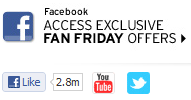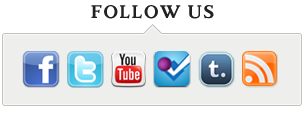The Social Follow Showcase

 There are quite a few ways to encourage website visitors to become social media followers and community members.
There are quite a few ways to encourage website visitors to become social media followers and community members.
Website Magazine has assembled a showcase of websites that have mastered social to the long-term benefit of search engine optimization and community building campaigns. It is important to understand before proceeding, however, that because there are different categories of sites, there are different strategies for encouraging website visitors to follow your social media profiles.
Below, we'll look at three classifications of sites (they may actually be the only three, in fact) - product vendors, service providers and information publishers:
Product Vendors
Internet retailers may just have the most difficult time in building a social following. The reasons should be obvious - they don't (and shouldn't) want to interrupt a visitor's path (the conversion funnel) with a request to like their page on Facebook or share it on Twitter - at least not until they've completed their purchase, which is truly the perfect opportunity to include a social follow feature.
However, retailers can also provide an incentive that not only increases the brand's audience on social media sites, but also encourages purchases. For example, Sephora does not disrupt their landing page with a focus on follow buttons. Instead, the beauty company carefully places the follow buttons below the fold, on the bottom left-hand side of the page (bottom example, below).
But the unique and attention-grabbing aspect is the featured Facebook exclusive promotion (top example, below) that encourages fans to not only like the Facebook page, but also receive exclusive product deals. This not only grows the brand's social media audience, but also encourages fans to make purchases.

Service Providers
The websites of businesses offering services, whether software or consulting (or both), have the most straightforward opportunities to generate social follows. Since these websites typically are not as large in terms of the number of pages, they can, should and often do increasingly take center stage so to speak.
In fact, it's not uncommon to see social follow buttons from Facebook, Twitter (and Google+, of course) in high-profile locations - typically in the header of a website as well as in the footer as sort of a catch-all of links. Social commerce software provider ShopIgniter is a great example of a company that includes prominent yet non-intrusive social follow buttons on its website.
The buttons blend well with the site, and stay stationary on the border around the content of the Web page. This means that although the buttons are featured on the top left side of the landing page (left example, below), they stay in the top left spot as a site visitor scrolls down the page. Furthermore, the company also links to Facebook and Twitter in the footer section of the landing page (right example, below).

![]()
Information Publishers: One of the reasons that social media has seen such explosive growth is because publishers - information vendors - immediately saw the benefit. As a result, this classification/category of site uses social follow strategies very liberally; too liberally, in the opinion of some.
In fact, nearly every page of an information publisher's website likely has some social follow functionality, and for good reason - users will follow (if they appreciate the content) and that drives repeat visits. Rolling Stone provides its audience with many opportunities to follow its content.
Not only does the publisher's website provide follow buttons for Facebook and Twitter in the upper right-hand corner of its landing page (top example, below), but once a site visitor scrolls down the page their are two more places that feature follow buttons for Facebook, Twitter, YouTube, Foursquare, Tumblr, and the company's RSS feed (bottom examples, below).
![]()



Subscribe to Our Newsletter!
Latest in Social Media










